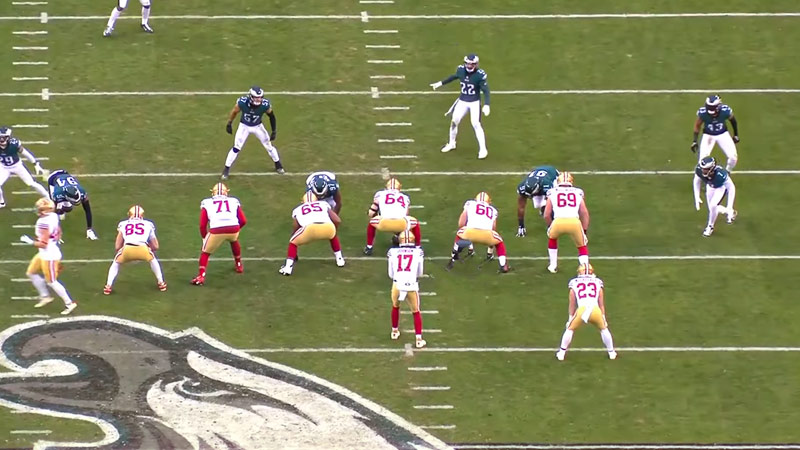American football is a game of strategy, where coaches and players constantly seek ways to outwit their opponents. Among the various defensive formations, the 3-4 Eagle Defense stands out as a formidable and versatile scheme.
This defensive alignment, featuring three down linemen and four linebackers, has gained popularity for its ability to apply relentless pressure on the quarterback, stifle the running game, and disrupt opposing offenses.
In this blog post, we’ll delve into the intricacies of the 3-4 Eagle Defense, exploring its benefits, drawbacks, and much more. So, stay focused.
What is Football 3-4 Eagle Defense
Typically, in American football, defensive formations are referred to by the number of defensive linemen and linebackers on the field. The “3-4 defense” is a well-established formation where there are three defensive linemen (two defensive ends and one nose tackle) and four linebackers behind them.
This defense is known for its versatility and ability to generate pressure on the quarterback while maintaining adequate pass coverage. The term “Eagle” is often used as a codename for specific plays, packages, or formations within a team’s defensive playbook, but it can vary from team to team.
The combination of “3-4 Eagle Defense” might be unique to a particular coaching staff or team and could involve specific alignments, assignments, or strategies designed to counter certain offensive schemes.
Principles of Football 3-4 Eagle Defense
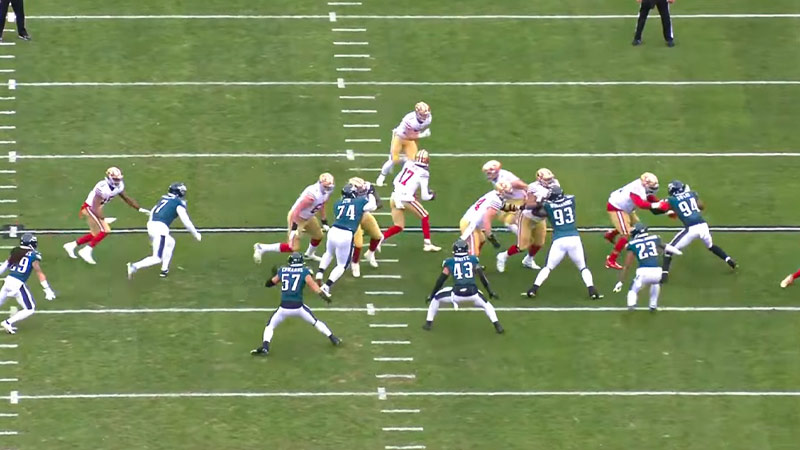
Some of the Principles of a 3-4 Defense are described in the next section below.
Personnel
The 3-4 defense utilizes three down linemen (two defensive ends and one nose tackle) and four linebackers, which provides more flexibility and potential for different blitzing and coverage packages.
Versatility
The 3-4 defense is known for its versatility. It can adjust to different offensive formations and plays, providing options for both run-stopping and pass-rushing. The outside linebackers are often expected to be versatile and skilled in both pass coverage and rushing the quarterback.
Gap Control
The linemen and linebackers in a 3-4 defense are responsible for specific gaps along the offensive line. Proper gap control is essential to prevent the offense from finding running lanes and gaining yards on the ground.
Pressure on the Quarterback
With four linebackers, a 3-4 defense can generate pass-rushing pressure from various angles. The defense can bring blitzes from different positions to disrupt the quarterback’s timing and force hurried throws.
Coverage Responsibilities
The linebackers and defensive backs work together to provide pass coverage in different areas of the field. This includes covering tight ends, running backs, and even dropping into deep zones to help the secondary.
Disguise and Pre-snap Movement
A well-coached 3-4 defense may use pre-snap movement and alignments to confuse the offense and disguise their intentions. This can make it difficult for the quarterback to read the defense and make adjustments at the line of scrimmage.
Regarding the term “Eagle Defense,” it’s important to understand that different teams and coaches may use codenames or terms specific to their playbooks.
The term “Eagle” might represent a specific formation or package that the coaching staff has developed, possibly with unique player assignments, alignments, or strategic objectives.
Roles of Football 3-4 Eagle Defense
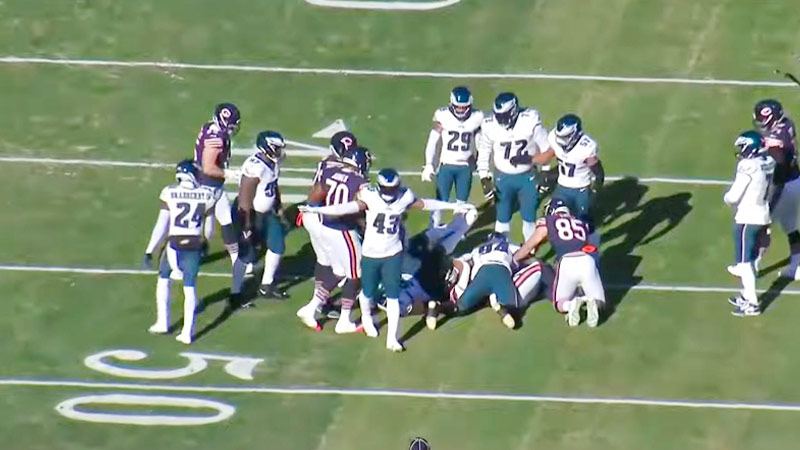
The 3-4 Eagle Defense is a popular defensive formation in American football that utilizes three down linemen and four linebackers. This scheme is known for its versatility and ability to adapt to various offensive strategies.
In this defensive system, the primary goal is to create confusion for the opposing offense, disrupt their plays, and put pressure on the quarterback. Let’s elaborate on the roles of the different positions in the 3-4 Eagle Defense:
Defensive Ends (DE)
- The two defensive ends are typically the largest and strongest players on the defensive line. They line up on the outside shoulder of the offensive tackles.
- Their main responsibility is to control the edge and contain running plays to the inside. By setting the edge, they prevent running backs from bouncing outside and force the play back into the pursuit of their teammates.
- In passing situations, the defensive ends become pass rushers. They must have a mix of power and speed to apply pressure on the quarterback, either by sacking him or forcing him to throw the ball early.
Nose Tackle (NT)
- The nose tackle is the anchor of the defensive line and lines up directly over the center. They are often the largest and strongest players on the defense.
- The primary role of the nose tackle is to occupy multiple offensive linemen, creating a “double-team” situation. This opens up opportunities for the linebackers to make plays.
- By drawing the attention of blockers, the nose tackle must be adept at maintaining his position and not getting pushed back. They are crucial in stopping inside runs and clogging up the middle.
Outside Linebackers (OLB)
- The 3-4 Eagle Defense typically features two outside linebackers who line up on the edges, just outside the defensive ends. They are also known as “edge rushers” or “hybrid” players because they must excel at both pass rushing and pass coverage.
- In run defense, the outside linebackers set the edge like the defensive ends. They are responsible for maintaining containment and not allowing the ball carrier to get to the outside.
- In passing situations, the outside linebackers become primary pass rushers. They must have excellent speed, agility, and pass-rushing moves to apply pressure on the quarterback and disrupt passing plays.
- Additionally, they need to drop back into pass coverage occasionally, covering running backs, and tight ends, or even dropping deep to cover receivers.
Inside Linebackers (ILB)
- The two inside linebackers play a critical role in the 3-4 Eagle Defense. They line up behind the defensive line and are often the leaders of the defense, responsible for making pre-snap adjustments and reading the offense.
- Against the run, the inside linebackers must be able to diagnose plays quickly, fill gaps, and make tackles. They are the primary run-stoppers in the middle of the field.
- In pass defense, the inside linebackers are responsible for covering the intermediate middle zones and defending against short to intermediate passes over the middle of the field.
- They may also be used as blitzers, attacking the quarterback on passing plays to disrupt the pocket and create pressure.
Safeties and Cornerbacks
- While not part of the 3-4 front, the defensive backs, including safeties and cornerbacks, play a vital role in the overall success of the defense.
- Safeties are the last line of defense and are responsible for preventing deep passes and providing run support. They must read the play, communicate with their teammates, and make tackles when necessary.
- Cornerbacks cover the wide receivers and try to prevent them from catching passes. Their ability to play tight coverage and break up passes is crucial to disrupting the opposing offense’s passing game.
The 3-4 Eagle Defense is highly flexible, allowing the defensive coordinator to mix and match different blitz packages, coverage schemes, and defensive alignments.
How to Practice the Strategies of Football 3-4 Eagle Defense
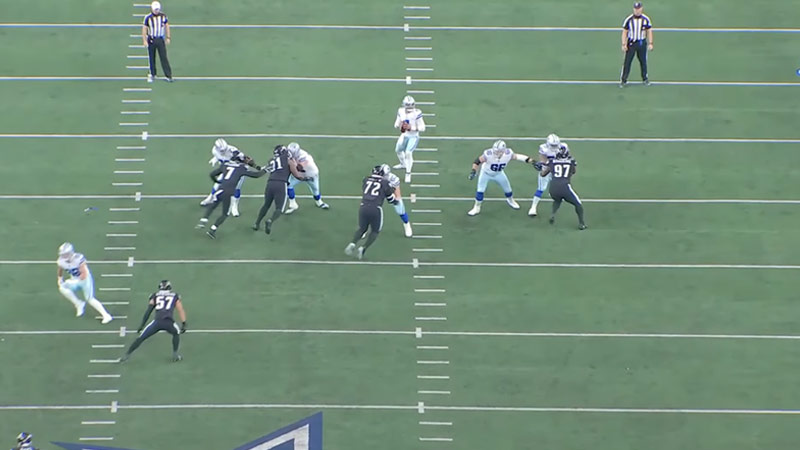
Practicing the strategies of the Football 3-4 Eagle Defense requires a systematic approach that involves individual drills, group drills, film study, and simulated game situations.
Here’s a step-by-step guide to help you practice and master the strategies of this defensive formation:
Understand the Defensive Playbook
Study the 3-4 Eagle Defense playbook thoroughly. Understand the roles, responsibilities, and alignments of each position in different situations. Familiarize yourself with the various coverages, blitz packages, and adjustments the defense can make.
Individual Position Drills
- Start with individual drills specific to each position in the 3-4 Eagle Defense. Work on techniques like pass-rushing moves, tackling, coverage skills, and gap control.
- Defensive ends and outside linebackers should focus on pass rushing, setting the edge, and dropping into coverage.
- Nose tackles need to work on leverage, hand placement, and holding their ground against double teams.
- Inside linebackers should practice reading plays, shedding blocks, and improving their coverage skills.
Group Drills
- Move on to group drills that involve coordination between players. Work on pass rush combinations, stunts, and twists involving the defensive line and linebackers.
- Practice run fits and gap control with the inside linebackers and defensive linemen.
- Conduct drills where the outside linebackers and safeties work together on pass coverage and run support.
Film Study
- Analyze game footage of successful 3-4 Eagle Defense performances. Observe how players execute their roles, make reads, and react to different offensive plays.
- Identify areas for improvement and learn from mistakes made during games.
- Film studies will help players understand how to adjust their strategies based on the opponent’s tendencies.
Simulated Game Situations
- Conduct scrimmages or simulated game situations where the defense faces the offense running plays they are likely to encounter in real games.
- Emphasize communication and coordination among players to ensure everyone understands their assignments and responsibilities.
Implementing Blitz Packages
- Work on specific blitz packages to put pressure on the offense. Develop well-timed blitzes from different angles and positions to keep the offense guessing.
- Coordinate with the defensive backs to ensure proper coverage behind the blitzing players.
Recognizing Offensive Formations
- Practice recognizing common offensive formations and predicting potential plays based on those formations.
- Learn to read the quarterback’s body language and tendencies to anticipate pass routes and plays.
Communication and Chemistry
Build strong communication and chemistry among the defensive players. Develop non-verbal signals and cues to communicate quickly and effectively on the field.
Game Simulation and Scouting Reports
Use game simulations and scouting reports to prepare for specific opponents. Study the tendencies of opposing offenses and adjust defensive strategies accordingly.
Repetition and Feedback
- Continuous repetition is essential to build muscle memory and instinctual reactions on the field.
- Provide feedback and constructive criticism to players during practice sessions to help them improve their techniques and decision-making.
By following these steps and maintaining a dedicated and disciplined approach to practice, players and teams can effectively learn and execute the strategies of the Football 3-4 Eagle Defense.
Benefits of 3-4 Eagle Defense
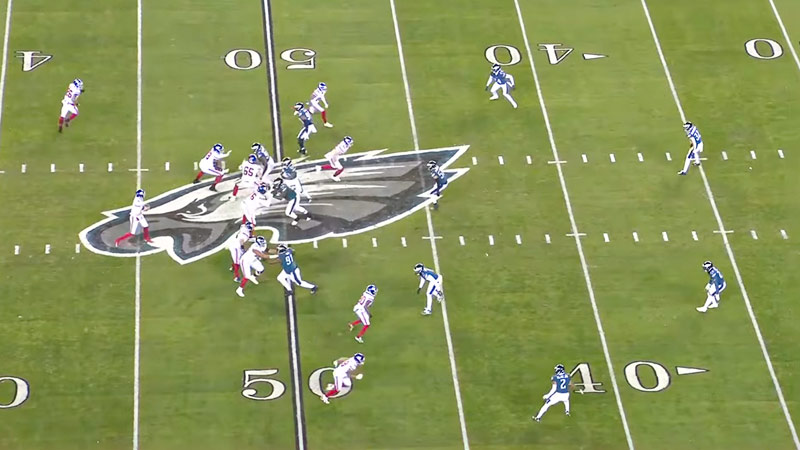
The 3-4 Eagle Defense offers several benefits and advantages that make it an attractive defensive scheme in American football. Some of the key benefits of the 3-4 Eagle Defense include:
Versatility
- The 3-4 Eagle Defense is known for its flexibility and adaptability. It allows defensive coordinators to mix and match different coverages, blitz packages, and alignments based on the strengths and weaknesses of the opponent’s offense.
- The ability to switch between various defensive looks keeps the offense guessing and makes it challenging for them to prepare and execute their game plan.
Pressure on Quarterback
- The 3-4 Eagle Defense is designed to generate consistent pressure on the quarterback. With four linebackers, including the outside linebackers who are skilled pass rushers, this defensive formation can create havoc in the backfield.
- By pressuring the quarterback, the defense can force hurried throws, disrupt timing, and increase the chances of sacks and turnovers.
Stopping the Run
- The 3-4 Eagle Defense is effective against the run due to its alignment with three down linemen and four linebackers. The nose tackle occupies blockers and clogs up the middle, allowing the inside linebackers to flow to the ball and make tackles.
- The outside linebackers and defensive ends play critical roles in setting the edge and preventing running backs from getting to the outside, funneling the ball carrier back toward the inside where the help is.
Coverage and Interceptions
- The formation’s combination of four linebackers and secondary players allows for better coverage in the intermediate areas of the field. The inside linebackers and safeties can cover tight ends, running backs, and receivers effectively.
- This enhanced coverage can lead to more interceptions and pass breakups, limiting the offense’s passing options and forcing turnovers.
Blitz Packages
- The 3-4 Eagle Defense can be particularly devastating when employing well-designed blitz packages. With four linebackers, the defense has more options to send extra rushers while still maintaining adequate coverage.
- This creates confusion for the offensive line and quarterback, increasing the likelihood of free rushers and disrupting the timing of passing plays.
Flexibility Against Spread Offenses
- The 3-4 Eagle Defense is well-suited to handle modern spread offenses that often feature multiple wide receivers and emphasize passing.
- The defense’s ability to adjust quickly, drop linebackers into coverage, and generate pressure allows it to challenge spread offenses effectively.
Disguise and Confusion
- The 3-4 Eagle Defense can disguise its intentions before the snap, making it difficult for the opposing offense to identify the defenders’ roles and responsibilities.
- This element of confusion can force the quarterback to make hurried decisions, leading to mistakes and turnovers.
Personnel Utilization
- The 3-4 Eagle Defense is a good fit for teams with linebackers who have diverse skill sets, including pass-rushing, coverage, and run-stopping abilities.
- It allows teams to utilize athletic players effectively, making the most of their talents to create a dynamic and formidable defense.
Drawbacks of 3-4 Eagle Defense
While the 3-4 Eagle Defense offers many benefits, it also has some drawbacks and challenges that teams and defensive coordinators need to consider:
Vulnerable to Power Running Game
- With only three down linemen, the 3-4 Eagle Defense can be susceptible to power running plays, especially if the opposing offensive line can get a strong push at the line of scrimmage.
- The lack of a fourth defensive lineman can make it harder to consistently control gaps and stop downhill running attacks.
Run Defense Relies on Nose Tackle
- The effectiveness of the 3-4 Eagle Defense against the run heavily depends on the performance of the nose tackle.
- If the nose tackle is unable to hold his ground against double teams or gets pushed back, it can create large running lanes for the opposing offense.
Coverage Limitations
- While the 3-4 Eagle Defense provides good coverage against intermediate areas of the field, it may struggle with deep coverage against fast and agile wide receivers.
- The defense’s reliance on linebackers for pass coverage can be challenging against talented tight ends and slot receivers who can exploit matchups.
Matchup Issues Against Spread Offenses
- While the 3-4 Eagle Defense can adapt to spread offenses, it may face matchup issues against quick and agile offensive players who exploit the gaps created by the defensive alignment.
- Spread offenses with quick passes and read-option plays can neutralize the effectiveness of the pass rush.
Pressure on Outside Linebackers
- The success of the 3-4 Eagle Defense often relies on the performance of the outside linebackers as pass rushers.
- If the outside linebackers struggle to generate pressure on the quarterback, it can put more burden on the secondary to cover for extended periods, making them vulnerable to big passing plays.
Personnel Requirements
- Implementing the 3-4 Eagle Defense effectively requires specific personnel with the right skill sets, especially at the outside linebacker position.
- Finding outside linebackers who excel both in pass rushing and pass coverage can be challenging and may limit the defense’s effectiveness.
Learning Curve for Players
- Transitioning to the 3-4 Eagle Defense can take time for players to grasp the new concepts, responsibilities, and adjustments required.
- The learning curve might lead to early-season struggles as players adjust to their new roles within the defensive scheme.
Risk of Big Plays
- Aggressive blitzing and pressure packages can leave the defense vulnerable to big plays if the blitz is not successful or the coverage breaks down.
- If the defense does not get to the quarterback quickly enough, it can lead to the offense exploiting the voids in the defense for significant gains.
FAQs
What makes the 3-4 Eagle Defense unique?
The 3-4 Eagle Defense distinguishes itself through its flexibility and adaptability. It allows for seamless shifts between various coverages, blitz packages, and alignments based on the opponent’s offensive tendencies.
This adaptability keeps the offense guessing and gives the defense a tactical advantage.
How does the 3-4 Eagle Defense generate pressure on the quarterback?
With four linebackers, including the agile outside linebackers, the 3-4 Eagle Defense can consistently apply pressure on the quarterback.
By employing well-designed blitz packages and stunts, the defense confuses the offensive line, creating opportunities for free rushers and forcing hurried throws.
Can the 3-4 Eagle Defense effectively stop the run?
While the 3-4 alignment may seem vulnerable against the run, it relies on the nose tackle’s ability to control the middle and occupy multiple blockers. This frees up the inside linebackers to flow to the ball and make tackles, making it effective against the run with proper execution.
Is the 3-4 Eagle Defense suitable against spread offenses?
Yes, the 3-4 Eagle Defense can adapt well to spread offenses. Its flexibility allows linebackers to drop into coverage while still maintaining the ability to generate pressure.
By challenging the quarterback’s decision-making and covering intermediate areas, it can neutralize the effectiveness of spread offenses.
What challenges do teams face when implementing the 3-4 Eagle Defense?
Implementing the 3-4 Eagle Defense requires specific personnel with diverse skill sets, particularly at the outside linebacker position. Finding players who can excel both in pass rushing and coverage can be a challenge.
Additionally, there might be a learning curve for players transitioning to this defensive scheme.
Wrapping Up
The 3-4 Eagle Defense represents a potent weapon in the arsenal of football strategies. Its adaptability, ability to pressure the quarterback, and versatility against various offensive schemes make it a popular choice among teams seeking to bolster their defensive prowess.
By understanding its unique benefits, addressing its drawbacks, and tailoring it to their personnel, teams can unleash the full potential of the 3-4 Eagle Defense and gain a competitive edge on the football field.
Whether facing power running teams or spread offenses, this dynamic defensive formation can prove to be a game-changer, leading to victories and defensive dominance. Thank you so much.

